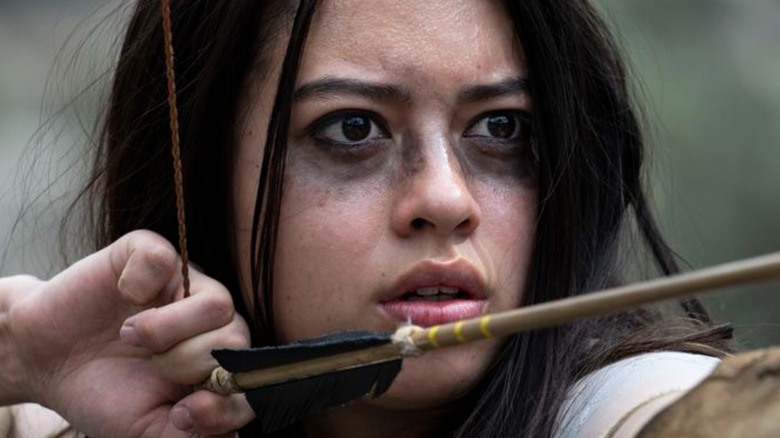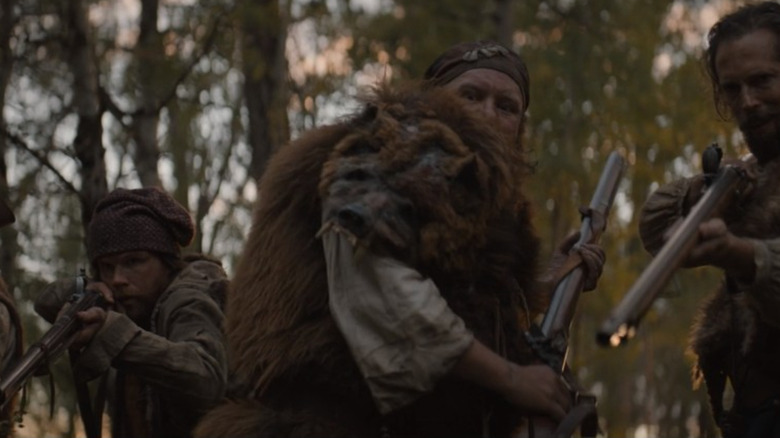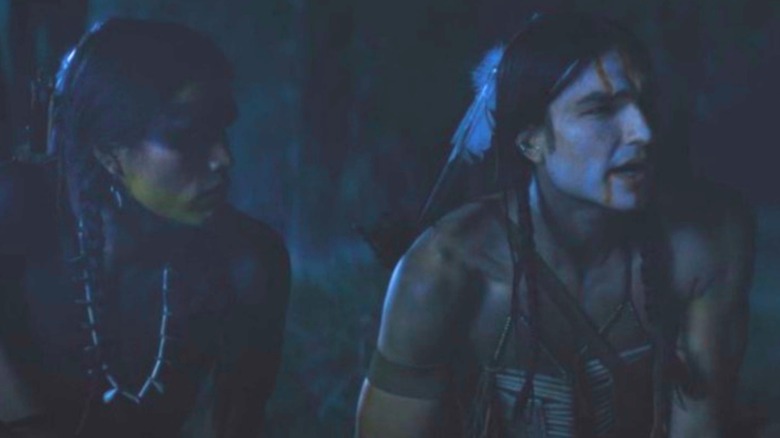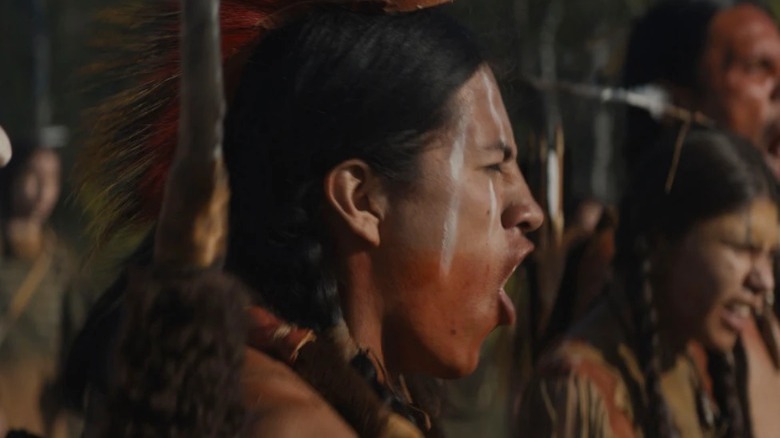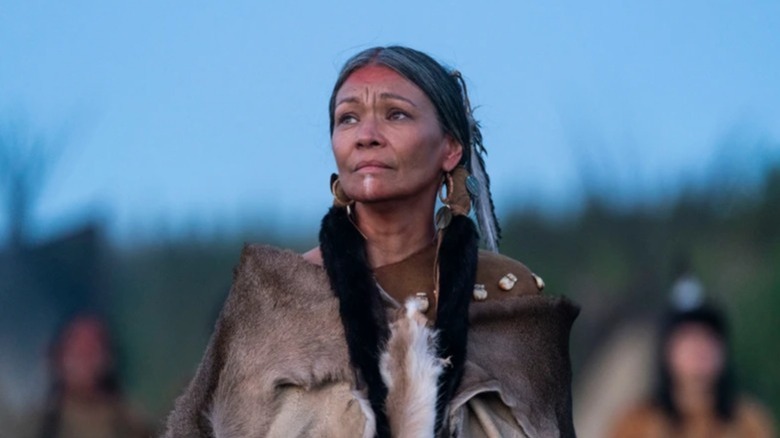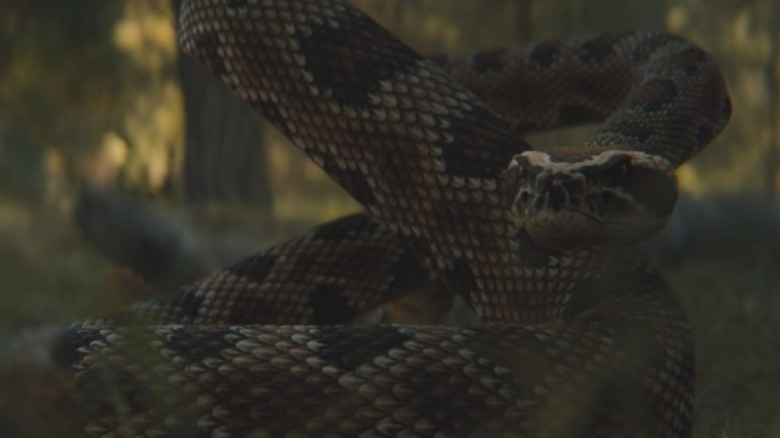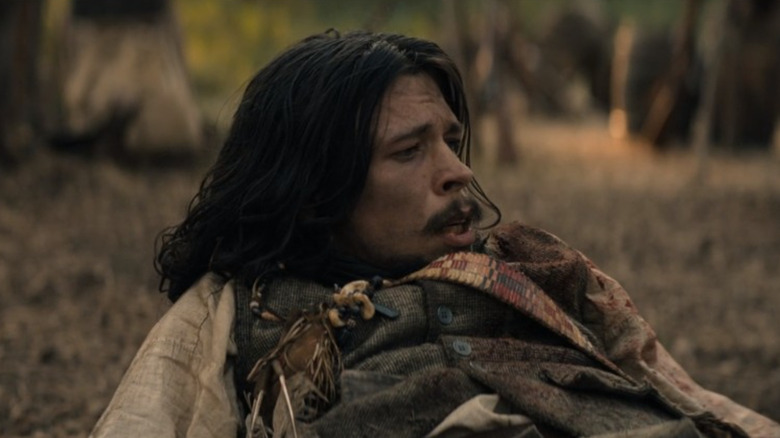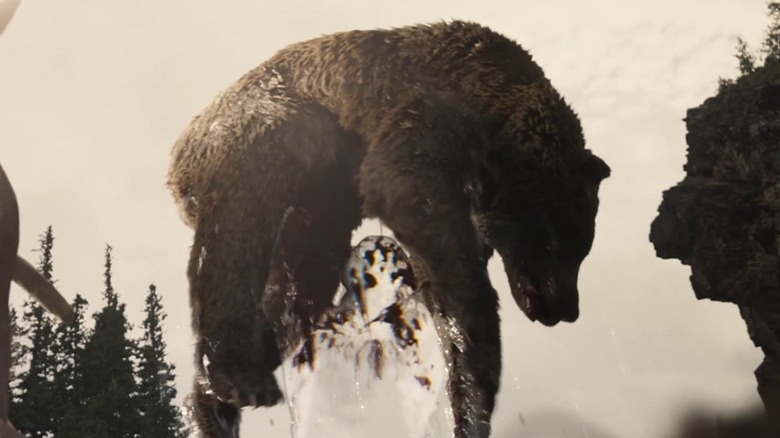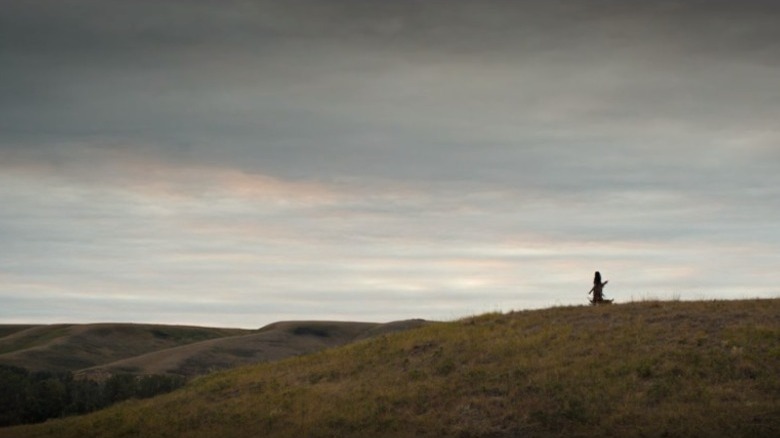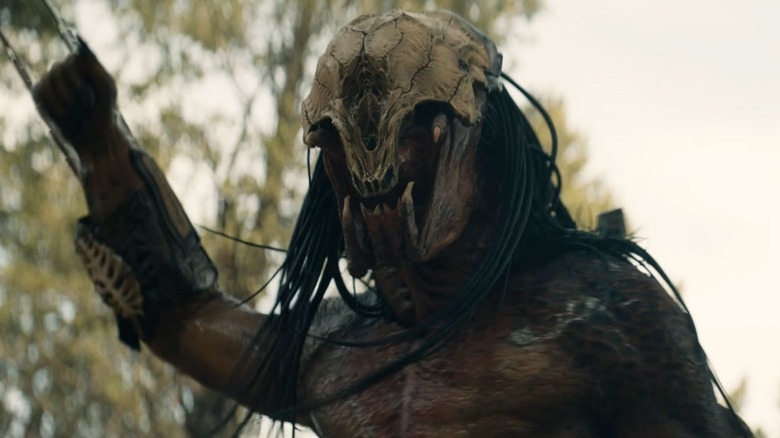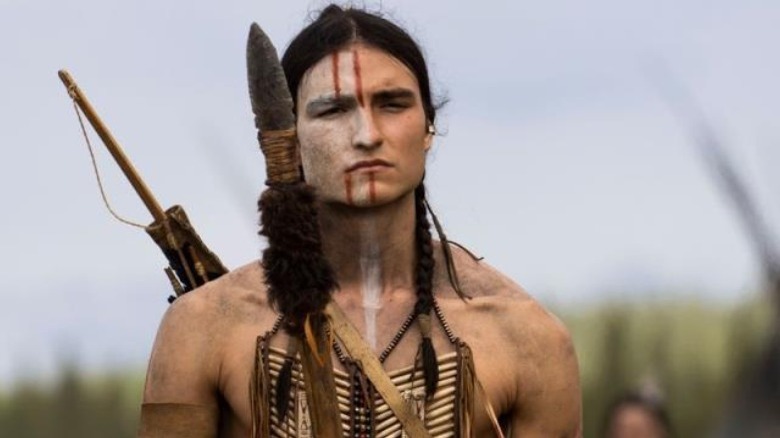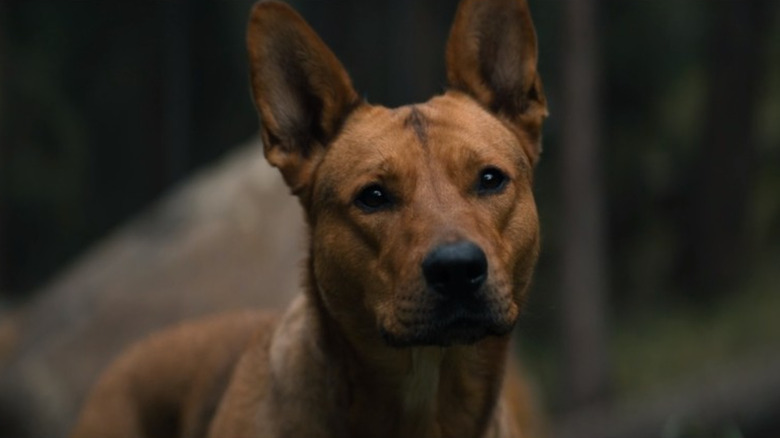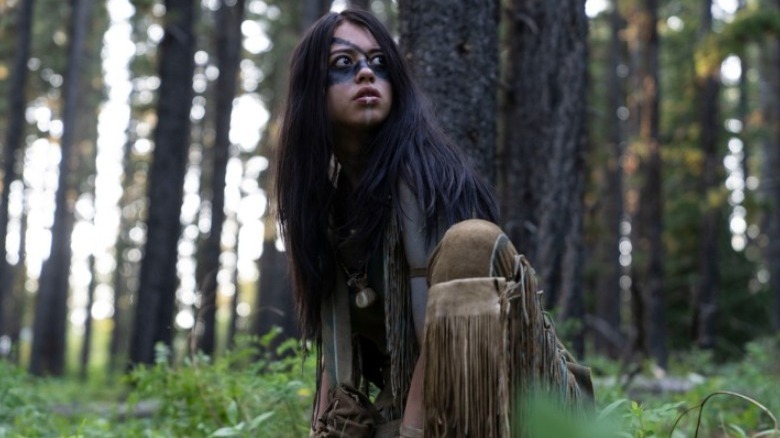Prey's Main Characters Ranked Worst To First
After years mired in B-movie purgatory, the "Predator" movie franchise has produced a surprise winner with the prequel "Prey." Critics are raving that the movie, set in the 18th-century Comanche nation, fixes many problems with the recent Predator movies and gets it back to its thrilling, propulsive basics of a human and an alien playing cat and mouse, so to speak. In a huge step forward for Indigenous representation, it's also the first major franchise movie with an exclusively Native American main cast. It tells a simple, gripping story in and of itself, while also including small details for the "Predator" fanatics of the world.
Amber Midthunder of "Legion" fame turns in an incredible star performance as lead character Naru, but she's far from alone. With minimal dialogue, "Prey" populates its small patch of the Northern Great Plains of early America with several memorable characters, as Naru has to navigate her relationships with various other friends and foes in addition to an alien visitor. In her quest to prove herself as a warrior and a healer, she encounters roadblocks from her tribe and gets hunted by man, animal, and Predator alike. From interloping fur traders to skilled Comanche warriors, here are the main characters of "Prey" ranked worst to first.
12. The Fur Traders
In telling a primarily Indigenous story, "Prey" naturally deals in some anti-colonial subtext. At first Naru and her dog Sarii come across unmistakable trappings like shell casings and steel traps, but eventually the men who left those signs show up at an inopportune moment and take her hostage. The French fur traders turn out to be responsible for the horrifying field of skinned buffalo, an immeasurable waste compared to the Comanche tradition of reverently using every part of a kill. When they capture Naru's brother Taabe, the trappers even sadistically slash him across the chest with a knife, seemingly just for the fun of it.
Lead by a portly, angry character credited only as "Spyglass," the fur traders try to use Naru and Taabe as bait to catch the Predator, only to be thoroughly slaughtered by the Predator's advanced weaponry in the most action-packed sequence of the film. Unsurprisingly, their grand scheme to catch a deadly alien being with a net and muskets that take forever to reload is unsuccessful, and they're soon littering the earth in a hail of mustaches and other body parts. Wasteful, interloping, and foolish, the fur traders are the worst characters in "Prey" by far.
11. Paaka
"Prey" doesn't waste a lot of time exploring its tertiary characters, so you might have missed Paaka, the Comanche who accompanies Naru to warn her brother about the Predator, before the three of them attempt to set a trap for the mountain lion. He watches Naru sharpen a weapon and cruelly taunts her. "It won't matter how sharp it is," he sneers, "if you're too afraid to use it." Paaka's one of the worst characters just by the virtue of his sullen and unhelpful attitude.
In just a few lines, Paaka lays out for us the sexism that Naru faces in her desire to prove herself as a warrior and hunter. Granted, when the time comes she does indeed hesitate too long to attack the mountain lion and accidentally falls from the tree, but it's not as if Paaka fares any better. After endlessly talking up the lion's razor-sharp teeth and promising that he would kill it, he gets abruptly cut off mid-sentence by the very same animal pulling him off of the tree and mauling him. In the end, Paaka's too busy being a bully to even keep lookout.
10. Wasape
For the majority of "Prey," all Naru wants to do is go on the hunt for the Predator and prove herself, and all anyone else wants to do is stop her. Wasape, another member of the tribe, uses his little screen time to be sneering and disdainful of Naru's dreams and to get into a literal fistfight in order to try and force her to return to the village against her will. It's a supremely wasteful amount of energy and time that could have been spent strategizing against the new, deadly foe in the wilderness.
In fact, Wasape's arrogance doesn't just waste time — it gets himself and the entire rest of his party killed when the Predator shows up. His last moments are spent completely failing to comprehend the significance of the Predator's laser-sight technology — which, to be fair, is fairly advanced for 1719, but that doesn't stop Naru from understanding it quickly later in the film. Wasape carries the unearned authority and arrogance of many middle-managers that have come before and after him, and meets a fittingly quick end in "Prey" for his foolhardiness.
9. Aruka
Aruka, Naru and Taabe's mother, has the thankless role that many mothers in cinema bear, of trying to talk sense into her young, brash child. She cautions Naru that the Comanche ritual of "kuhtaamia" isn't about proving herself as a warrior, but as adept at survival in the abstract sense. And she reminds Naru that her healing skills saved Puhi's life from the mountain lion attack, and that she shouldn't turn her back on these things that come naturally to her, which is sound counsel.
But narratively, Aruka is mostly there to serve as yet another wet blanket that tries to keep our killer heroine from realizing her true, Predator-hunting destiny, and so she doesn't rank terribly high among the main characters at earning our affection. She even puts a little too harsh a spice on it when she tells Naru to stay put after she gets knocked out during the mountain lion hunt: "If your brother needed you, he wouldn't have brought you here." Ouch, Aruka. You could've just said, "You just hit your head pretty badly and should probably not get right back up," or something. She may be generally in the right, but Aruka's not winning Mother of the Year anytime soon.
8. The Snake
Director Dan Trachtenberg fills "Prey" with several small moments that play to the movie's general themes of the hunter and the hunted switching places. A particularly memorable snake makes the most of just a couple of scenes in cluing us in on just how thoroughly the arrival of a Predator has disrupted the local food chain. We first see our scaly friend doing what snakes do — hunting and catching a mouse — which it swallows in one massive gulp.
The tables are turned immediately, however, as the snake is subsequently punctured by huge claws and then skinned, all witnessed through the translucent shimmer of the Predator's cloaking armor. Just as quickly as a natural predator captures its prey, it becomes prey itself. The alien predator has disrupted the natural flow of things, just as humans like the fur traders do when they slaughter buffalo wholesale for economic profit. RIP to the snake in "Prey," next seen startling Naru in its unnerving skinned state. (Fortunately, as it was computer generated, no snakes were harmed in the making of the movie.)
7. Raphael
The only member of the fur traders to really distinguish himself individually or show any compassion, Raphael ends up playing a small but key part in Naru's takedown of the Predator, so credit where credit's due. Other than his ability to speak Comanche, he doesn't exactly do anything to help Naru and Taabe at first, aside from confirming how hopeless their situation is. Gallingly, he actually tells Naru that she should be helping the fur traders try to take down the "beast," rudely asking someone being held in a cage to pool resources.
Later, after the fur traders' disastrous standoff with the Predator leaves Raphael with one less leg than he had before, he trades a pistol to Naru for a little help staunching the bleeding. When she treats him with some of the orange tutsia flower petals that cool the blood, it helps her realize watching from afar that the effects of the flower can hide people from the Predator's heat vision. Unfortunately Raphael yelps when stepped on, and the Predator quickly shows him to the afterlife to join his missing foot. Still, he does prove mildly useful while alive, and that pistol turns out to be a pretty crucial part of "Predator" lore.
6. The Bear
Full of rage like it was the second choice for that scene in "The Revenant," a massive bear arrives halfway through "Prey" and leaves one heck of an impression. In one of the more thrilling sequences, Sarii and Naru make a narrow escape from the charging grizzly, with the clever dog leading it back and forth to momentarily distract it. Soon, however, it has Naru hopelessly pinned down under some branches that it quickly begins tearing through. If this were just a movie about survival without any alien interference, it could very well be the end of the story.
The Predator conveniently arrives to interrupt, however, and the bear makes a more than decent showing for itself and goes toe-to-toe with the alien for several rounds. The bear comes in a solid second place to only Naru herself in the "damage done to the Predator" category, as we see the Predator even have to spend time patching itself up afterwards. It makes the extremely gory scene when the bear gets disemboweled while held aloft a little bittersweet (aside from being generally awesome). We're glad he didn't get Naru, but the bear deserved a better fate.
5. The Northern Great Plains
Even though they always get things wrong about it, we're treated to countless TV shows and treacly romantic comedies where "New York City is like another character." So many stories, from Woody Allen movies to "Sex and the City," lean heavily on the Big Apple to provide a sense of personality and place. By that logic, credit should be given to the Northern Great Plains of 1719 that provide the backdrop for "Prey." Like the jungle in the original "Predator," the wilderness becomes a vivid and integral part of the story, and key to the Predator's undoing.
We see the Plains in sweeping landscape shots, under austere and gloomy skies that set the mood perfectly for "Prey" and its gripping tale of survival. In a key bit of foreshadowing, Naru's near-death in a mud pit becomes an important part of her eventual victory when she traps the Predator in the exact same place. The harsh but beautiful conditions of the Northern Great Plains are as welcome an addition to the "Predator" mythos as Naru and everything else. Predators might have all the fancy light-up weapons and invisibility technology, but as humans we've got a home-field advantage that can't be beat.
4. The Predator
On a certain level, you have to feel for the Predator in "Prey." Here this innocent alien hunter is just trying to complete another day working at collecting skulls for whatever reason, and then he keeps getting attacked by progressively more and more persistent animals and increasingly cunning human beings. What does a skull-faced alien have to do to finish his strange and unexplained field assignment to find "the strongest beast," as Raphael speculates?
We get a few indications that the Predator itself is as much of a rookie as Naru in terms of combat, as they both patch up their wounds in a parallel sequence. It begins the movie using mostly hand-held weapons like its trusty double claws, and then seemingly loses patience after a progressively more frustrating day and pulls out the fancy tech to take out the fur traders when they gang up on him. Eventually, dealing with multiple injuries and howling with rage, it's trapped in mud and has its own laser-targeting system turned against it by Naru. Though the Predator's motives, as per usual, are unknown, and it doesn't get what you'd call a character arc, it's a worthy opponent and key to Naru's journey in earning the title of War Chief and respect among her tribe.
3. Taabe
Initially, Taabe seems like a cold and staid character who exists to be an antagonist for Naru. As her competent older brother, he saves her life and kills the mountain lion, and it seems like Naru will never get the respect she deserves from him or the rest of the tribe. He also awakens her each morning by rudely kicking her in the shoulder. But as he grows more impressed with her skill and determination, he reveals that it was her strategy that defeated the "big cat" to begin with, and he becomes the only male character who doesn't constantly tell Naru to go home or discount her ambitions by default. By that alone, he's one of the more memorable and admirable characters in the film.
In the second half of "Prey," he also displays some truly stunning heroics when he and Naru fight the Predator together. His aerial flip from horseback to run the Predator through with a spear might be a top-five action moment for the entire franchise, and his ultimate realization that his death is near is compelling and tragic in a movie that hardly gives us time to mourn, despite dozens of deaths. His sacrifice truly hurts, but his confidence that his sister will be the one to bring down their foe rings loud and clear. We'll miss you, Taabe.
2. Sarii
Everyone loves a loyal dog companion in a movie, from "The Artist" to the famous Asta in "The Thin Man." For many the runaway MVP of "Prey" is Sarii, Naru's steadfast companion throughout the film who steals nearly every scene, simply by an excitable energy and expressive eyes. Speaking with FreshFiction.tv, director Dan Trachtenberg revealed that Sarii is played by Coco, a breed called a "Carolina dog" that is believed to be the sort that Comanche people kept at the time. Coco turned in stellar work, but was apparently difficult to wrangle as she hadn't been trained for years like most movie dogs.
Ultimately, she won hearts among the cast and crew, and everyone who saw Trachtenberg's early cuts of the film demanded more. "[Everyone] was like, 'More dog! We love the dog!'" the filmmaker reported. "I was like, 'You don't understand. We are using every usable frame of this dog.'" In an intentional homage to Mad Max and his dog in "The Road Warrior," Sarii and Naru make up the heart of the film. Sarii helps Naru escape a massive grizzly bear, and ultimately distracts the Predator at a key moment as well. Sarii more than earns a place among the greatest cinematic canine companions.
1. Naru
The only reason "Prey" succeeds so thoroughly in simplifying the "Predator" formula back down to its basic appeal is because it has a uniquely compelling lead character in Naru, brought to life wonderfully by Amber Midthunder. It's almost the Predator's bad luck that it arrives on Earth right at the point in Naru's life that she's so geared up to prove her ferociousness through the rite of kuhtaamia — if the Predator waited a week, she might have killed the grizzly bear and gotten it out of her system. As the story unfolds, Naru is hunting the Predator long before it even recognizes her as a viable threat, and this ultimately proves key to her victory.
Without overplaying the movie's themes through dialogue, Naru also embodies centuries of women suffering from condescending misogynist views about their toughness. It quietly drives home a particularly powerful point about representation when Naru shares a meaningful look with a young Comanche girl after being named War Chief. She's by far the smartest human character in "Prey" — her plan to catch the mountain lion succeeds even after she gets knocked out, and she ends up turning the Predator's own technology against it. She uses her environment to her advantage, always stays alert, and ultimately saves her entire tribe from destruction. We salute the best character in "Prey," and perhaps the best action hero in the entire "Predator" franchise.
